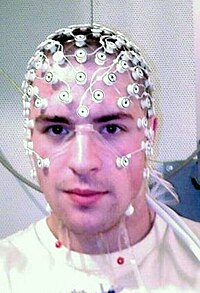
Photo from wikipedia
The attentional blink (AB) effect is the reduced probability of reporting a second target (T2) that appears shortly after a first one (T1) within a rapidly presented sequence of distractors.… Click to show full abstract
The attentional blink (AB) effect is the reduced probability of reporting a second target (T2) that appears shortly after a first one (T1) within a rapidly presented sequence of distractors. The AB effect has been shown to be reduced following intensive mental training in the form of mindfulness meditation, with a corresponding reduction in T1-evoked P3b brain potentials. However, the mechanisms underlying these effects remain unknown. We propose a dynamical-systems model of the AB, in which attentional load is described as the response of a dynamical system to incoming impulse signals. Non-task related mental activity is represented by additive noise modulated by meditation. The model provides a parsimonious computational framework relating behavioral performance, evoked brain potentials and training through the concept of reduced mental noise.
Journal Title: PLoS Computational Biology
Year Published: 2022
Link to full text (if available)
Share on Social Media: Sign Up to like & get
recommendations!